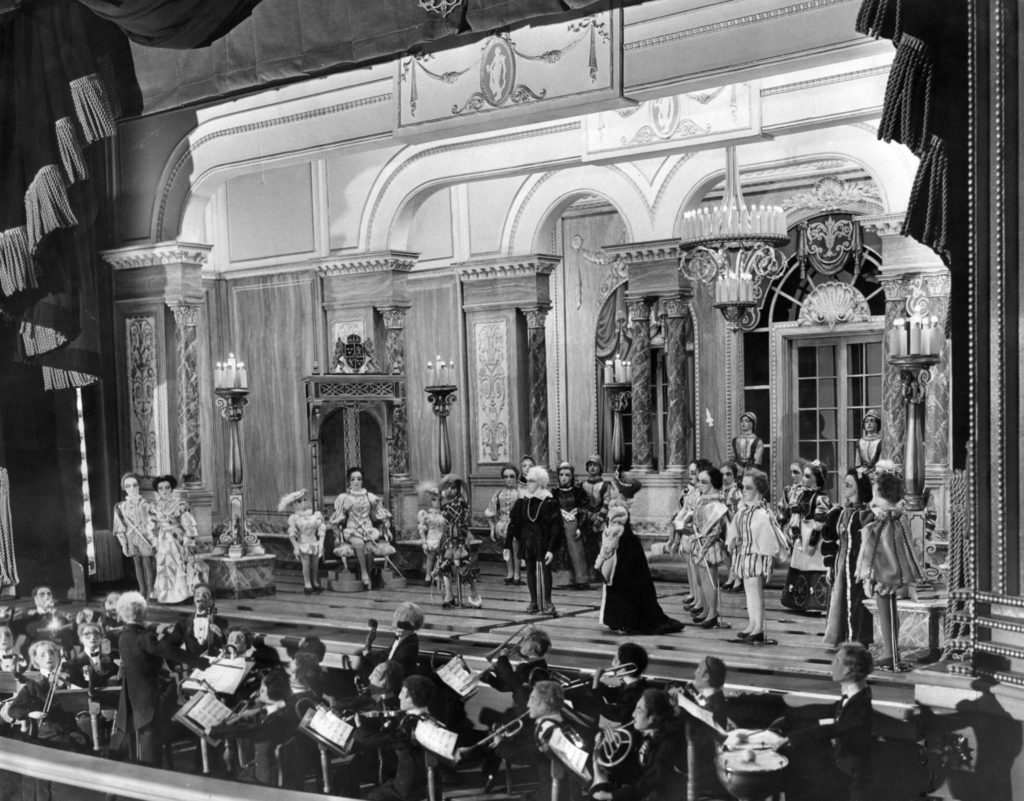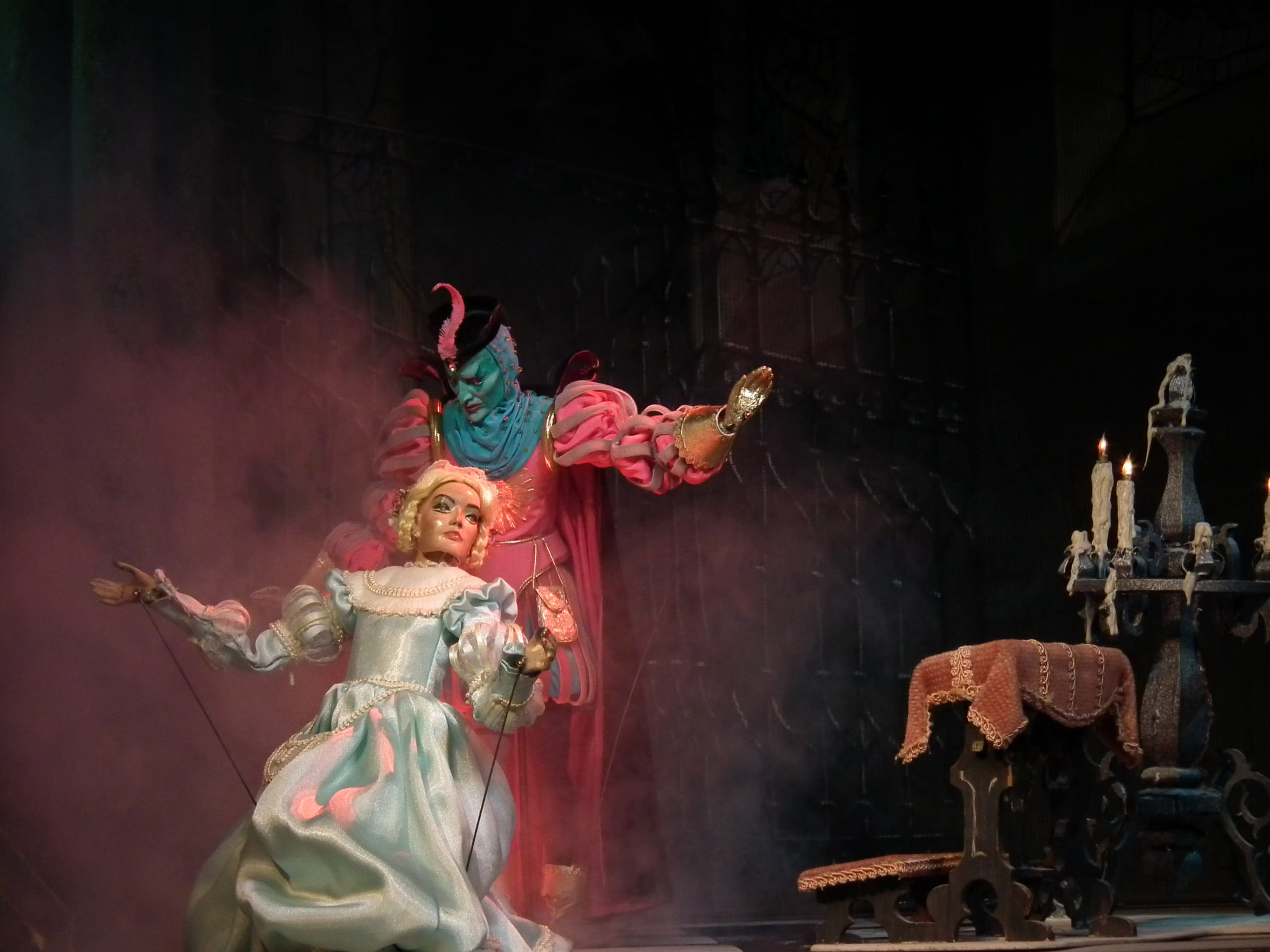The Kungsholm Restaurant, which occupied the same Ontario Street building recently vacated by Lawry’s, had an unusual attraction for luring diners to its Swedish smorgasbord: a 95-seat theater in which it put on entire operas performed by puppets.
While an LP played over the sound system, a team of puppeteers crouched beneath the six-foot-by-eight-foot stage, raising and pulling the metal rods that manipulated the arms and heads of the Kungsholm Miniature Grand Opera’s tiny Tristan, Brunhilde, Canio, and Pagliacci. The little wooden singers were written up in Popular Mechanics, and introduced generations of children to the world’s great operas. For a time, until the Lyric Opera opened in 1954, the Miniature Grand Opera was the only opera company in Chicago.
“It was the first opera I ever saw,” recalled Dianne Bowman. “Madame Butterfly. It was in the ’40s, so I was seven or eight years old. We were visiting from out of town, so it was a must-see attraction. I don’t think I would have been as interested in a real opera.”
Jay Schachner thought the puppets were so realistic and compelling that “you got lost. You forget it’s a puppet performance. It’s like you were really at the opera. At the end, the puppeteers would stand. It was always a shock.”
Rod puppet opera was invented in Chicago and reached its peak of popularity at the Kungsholm, which was open from 1937 to 1971 — and still lives on today in the basement of a suburban park district. An old-fashioned art form with an Old World feel, it has survived due to the obsessions of three generations of puppeteers for whom it’s been a labor of love, if not a livelihood.

The father of the puppet opera was Ernest Wolff, who became fascinated with opera when his mother took him to see a performance of Carmen at the Chicago Auditorium in 1925 when he was 12 years old. Wolff began collecting opera records, then building sets and peopling them with clay models. When Wolff put on a show of six opera arias in his basement, his friends asked, “Can’t you give your figures some action so they appear alive?”
Wolff’s mother bought him German dolls with porcelain heads and sawdust-stuffed bodies. Wolff decided not to build marionettes, like the Salzburg opera depicted in The Sound of Music. According to the book Chicago’s Miniature Grand Operas by Luman Coad, “their strings would tangle in the overhead lights and the puppets would not be able to pass through doorways. The solution was to operate the figures from beneath the stage floor. The inspiration may have been the Ukrainian vertep, a seasonal folk puppet show which Mrs. Wolff could have seen in Czechoslovakia when she was young.”
Wolff’s Victor Puppet Opera so charmed its audiences of “ladies clubs, musical societies, lodges, social groups and schools” that he was invited to perform for six months at the 1939 New York World’s Fair. Returning to Chicago, he put on one last show at DePaul University’s Kimball Auditorium. Frederick Chramer, owner of the Kungsholm Restaurant, was in the audience. Seeing a potential gimmick, Chramer arranged to buy the opera and move it into a fourth-floor movie theater in his restaurant.
When Wolff got home from the war, though, he decided the Chramer had stolen his creation and failed to give him proper credit. So he sued the restaurant, winning $15,000 and the right to continue performing puppet operas under his own name. Although Wolff’s operas were broadcast on NBC and he secured a residence at the Hyde Park Hotel, puppeteering didn’t pay the bills. He sold his company of puppets to the Kungsholm and went into banking.

“He talked about [the puppet opera] a lot,” said Bette Coffey, who worked with Wolff at American National Bank and Trust. “He was an opera buff.”
Like Ernest Wolff, William Fosser also fell in love with opera at an early age. When he was seven years old, an aunt took him to see Il Trovatore. Fascinated with the music and the costumes, Fosser built his own puppets, showed them to Frederick Chramer, and was hired to work beneath the stage at the Kungsholm. From 1964 to 1967, Fosser was the Kungsholm Miniature Opera’s Artistic Director. After the restaurant closed, Fosser determined that its puppet opera should live on.
He worked as a set decorator for such made-in-Chicago Hollywood movies as Ordinary People, Backdraft, and Home Alone, providing him the income to design more supple, realistic puppets than those he had worked with at Kungsholm (Fosser’s puppets featured 16 “points of articulation,” versus Kungsholm’s four). Still, it was hard to find a home for an art form as eccentric as the puppet opera. Fosser performed at the Magic Pan restaurant and the Museum of Science and Industry, without much success. Finally, in 1993, he was invited to move into the basement of Park Central, the headquarters of the Rolling Meadows Park District. Fosser named his company Opera in Focus because it performed arias from famous operas, and because its circular proscenium is designed to resemble a camera lens.
“At the Kungsholm, we did whole operas, so a performance there was going to go two-and-a-half, three hours,” he said in 1998. “It was exhausting for us and it was exhausting for the audience. I decided to do just the famous scenes. The main thing I want to do is introduce students and adults to opera.”
In 2000, Justin Snyder was a student at Reavis High School in Burbank, looking for a job. A “strange, nerdy kid” who listened to his grandfather’s opera records and made puppet movies, he saw an ad seeking a puppeteer at Opera in Focus. Rolling Meadows was a long drive from his home in Mount Greenwood, but he thought, “this is everything I love, opera and puppetry combined.” He told Fosser, “I want to train to be a puppeteer.” Fosser adopted Snyder and his brother, Shayne, as his protégés and successors. Never married, he used to say “the puppeteers and the puppets are my family.” Fosser took his young apprentices to the Civic Opera, telling them to watch how the singers exhaled after a long note, and learn to reproduce their relaxation in their puppets.
“One of the first things Bill Fosser taught me is to be an effective puppeteer, the most important talent to develop is the ability to just shut yourself completely off,” Snyder says. “When I perform onstage, I can’t perform as me: I might be Marguerite in Faust or I might be Sportin’ Life in Porgy and Bess. You as a puppeteer have to be able to get into the psychology and the physicality of that character.”
When Fosser died in 2006, he left Opera in Focus to the Snyder brothers, who continue to perform puppet opera in Rolling Meadows. Many puppet opera fans are senior citizens who remember the performances at the Kungsholm. Snyder updated the repertoire with selections from the Wizard of Oz and Sweeney Todd, and invites school groups to the theater. Opera In Focus was closed for a year and a half due to the pandemic. Since its August reopening, shows have been “few and far between,” as senior groups are reluctant to attend. Still, the 39-year-old Synder, who most recently worked as a stone carver in the monument business, is determined to keep the puppet opera alive, as a tribute to Fosser’s memory.
“He was like my granddad,” Snyder said. “From the moment I met Bill until he passed, he was my best friend. If it weren’t for the connection we had to Bill, and the promise we made to him, we might not be doing it.”



